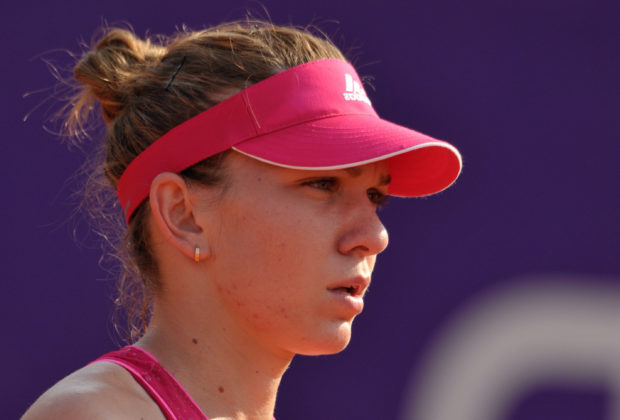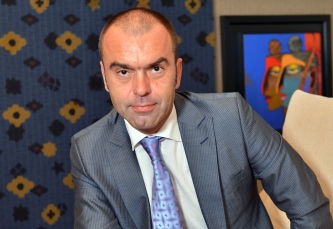
The Halep effect
In one year and two months, Simona Halep has climbed 62 places in the tennis world ranking, up to the 2nd position, a place where no other Romanian women player has ever reached before. Her fast and continuous ascent has an explanation: she has rediscovered the pleasure of playing, aggressiveness on the tennis court, intelligence, ambition.
The hall is cramming with people, slowly but surely. One by one, the journalists put the hard wooden seats down and take their places. But she is already there, sitting at a table with a few bottles of water and the microphone. Simona is smiling. Very often, things are the other way around – the player is late and the journalists are kept waiting. It has been just an hour since the Roland Garros women`s final has ended; this is the wonderful, torrid 7th of June 2014 and she is looking patiently while people fill up the rows. There is a kind of humming in the air and then, suddenly, there is silence. This is the sign that the press conference can start.
It is the first time when the Main Conference Room is full for Simona Halep. She had to get to the last act in Paris so that people put a high value on her; a high value that players such as Maria Șarapova, Serena Williams or yet, players of a lower value but with a better marketing, such as Eugenie Bouchard, have obtained faster. The questions are flowing, the portable microphones are passing from American journalists to the Chinese and then to the British, the accents are mixing into universal English and Simona is answering the questions. Calmly, elaborated, emotional, firmly, funny, depending on the question. The feelings she is having are also mixed. She played the first Grand Slam final of her career, on the court where she has won in 2008 as junior, she met Șarapova, a player whom she admires. But, Simona did not let herself become overwhelmed by Șarapova, she lost almost had to the limit 4-6, 7-6 (6), 4-6, a match where the game was raised to a stunning quality level. What does one feel in such moments?
Immediately after the last ball, after the players shook hands at the net, while Șarapova was going up to the stand to hug the members of her team, the Romanian girl hid her face in the towel. To keep her tears private; at least for a short while. But, a French TV camera captures the moment when a few drops of crystal liquid fall down Simona`s cheeks and roll towards the chin. This is what she felt then; she felt that she could free herself by crying. She shed some tears because she was close, she was happy that, before anything else, she has played a Grand Slam final. The final of one of the most powerful tournaments of all.
At that point, she was the world`s fourth tennis player. After Roland Gaross, she became number 3. Exactly one year before, when she lost during the first tour in Paris, she was number 57 in the world ranking. Although quite a while has passed since then, the question “How did this impressive leap happen?” is still heard, written, asked. And the answer is always the same: because there cannot be another way. Because it is simple, and it is complicated, but this is how it happened. Halep needed a release. As a paradox, this release came after a match she lost during the first tour in Madrid, in 2013. She has received a wild card for the main draw from Ion Țiriac, the promoter of the tournament, but she has caved to the Spanyard Lourdes Domínguez Lino. The three hours of tennis played under the hot sun of Spain`s capital city had offered her some good feelings. Emotions she had forgotten during the last few years.
Because, at 16 and a half years old, when she won the junior`s Roland Garros, Simona Halep was, as the great champion Virginia Ruzici said, “an attacker”. This fact has drawn the attention of Virginia, the only Romanian woman player to win a Grand Slam tournament, right there in Paris, in 1978. This is why, in 2008 she proposed to the young player to act as her manager. It was a long term decision. Ruzici appreciated the girl`s fighter attitude, the fact that she to be meet the ball early, to have the initiative for every point, to lead the game. And, “I believe her backhand is a world class stroke”, added the Romanian champion, who lives in Paris for more than 30 years. Where are all these coming from? It is time to go a few episodes back.
It all started thanks to the ambition of her father, Stere. He has guided her towards tennis when she was only 4 and a half years old. “It was the dream I had for myself when I was young, but, because of the situation back then, I was not able to achieve it”, said Stere Halep at the end of last year. “It was then when I said to myself that one of my children shall become a champion. First there was the boy, Nicușor – he played football, tennis, karate, but things did not work out. Then she came, the star she is today, for whom I was able to give everything so she could become a champion”. Simona adds: “He sacrificed everything. Not many parents have this courage, to risk for a very young child without the guarantee of success.” At 6 years old, when she won the third place at Cupa Litoralului, in Constanța, I knew she will go a long way,” added the father. He has felt it, wanted it, but he has rather dreamed it.
Without the ambition and the courageous, almost crazy investment of her father, we would not talk about Simona Halep today. She won in Paris at the juniors` tournament; a final played on Court number 2, with stone walls and a board embellished with ivy. This is where she came back this year to play a third round match with Maria Teresa Torró Flor. And the hope of Stere Halep has increased at the same time with success. Yet, some more years had to pass so that the dream could become more round, almost perfect.
And so, we go back to Madrid 2013. That match Simona has lost has brought back to her the memories from the days when she used to play freely, fluently, aggressively. Next week, after the qualifying matches, she has got to the semi-finals in Rome, a tournament that can be compared with Madrid, from the point of view of value.
In June she has won the first two titles of her career, in Nürnberg, on a clay and only 7 days later in ‘s-Hertogenbosch on grass, a tournament where she did not even want to go play because she was tired and had a minor injury. She had decided to take the train and participate and did not stop until she held the cup in her arms. In July, at Budapest, came trophy number 3. During all this time, her position in the world ranking got better and better.
The week before the US Open, she triumphed at New Haven, bringing down another barrier. In New York, at the last Grand Slam tournament of 2013, she got to the 4th round and back then, that was her best result so far. In autumn, she had victories at Moscow and Sofia; the last one was at the Tournament of Champions, played in round robin format. Having no other direction but up, Halep closed the year on the 11th place in the world ranking. The rise also continued in 2014, almost in a virulent way; she played the ¼ finals at the Australian Open, also a Grand Slam tournament; the 7th title at Doha; the semifinals at Indian Wells; the final at Madrid, the place where everything has started last year; and the final at Roland Garros. Things happened like in a dream; like in an incredible and positive trance. How did they happen? The answer is – because Simona Halep did things right. She locked in a chest all the years during which her style of playing refined as a defensive one, in contradiction with her aggressive nature. She took the chest in the attic and left it there. She started playing every match like in the old days, wishing to impose the pace, staying close to the base line so she could meet the ball early, and using the angles to open the court. It all seems simple, but it’s not, especially when you are 1,68 m tall. It seems simple and sometimes it is, when native intelligence is helping you, when you own a view of the court. And this is exactly how Simona is – smart, intuitive, always looking for solutions, independent, ambitious.
Now, with a team by her side, a team that the Belgium coach Wim Fissette is also part of, she feels much better. Protected, but also free. This is why, after Paris, the Wimbledon semifinal followed; a phase where no other Romanian woman player has ever been before. Then, she had a home victory in Bucharest, in the humid and suffocated July air. “The most emotional trophy I have ever won”, as she said. She wanted so much to play in Romania that she played with both ankles tightly bound due to older and newer injuries. Because Simona is also like this: she grinds her teeth and does not give up when the stake is high; for ambition, but also for the soul.
“I am not playing for the fame or for the money, I am not playing to be known by people. I play because I love this sport, I have worked very much to get here and I think I deserve to be on the 2rd place and to play in the finals of the Grand Slam tours. For me this is something natural, I want to be as natural as possible, and in fact I really am, both on the field and also outside it. In my life there are people close to me with whom I share this success, my friends, my family, my fans, I don`t want to consider myself as being something wow, because many players have won much more than me at my age. I am a normal player and a normal girl and I want to stay like this”, says Simona Halep when describing herself. And no one can argue with her, although her brilliant route has just started. It is the route that no other Romanian woman player has walked before. From now on, she is the benchmark.









